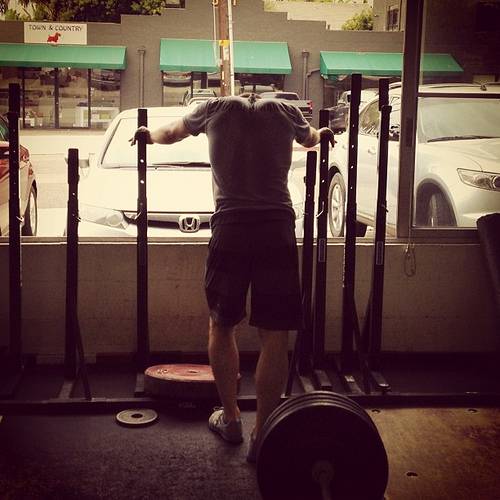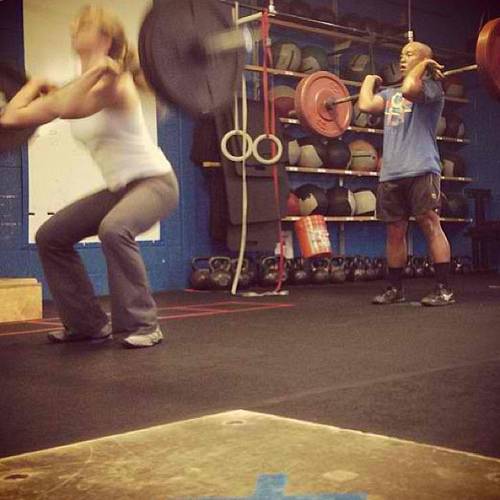This is perhaps the ultimate conundrum within strength training – how to make continual strength increases while staying free from injury. By its very nature, lifting heavier and heavier takes its toll on the body. After a while the gains slow down or even stop, if the body doesn’t come to a grinding halt before that.
Being out of the game sucks, whatever the reason. The aim of the game is to gradually progress your strength whilst keeping your body in a good enough condition to continue to be able to do so (and enjoy life in the process.) Getting stronger and staying fit and healthy should go hand in hand. The more sustainable your training plan is, the longer you are going to be able to continually progress without hitting a wall due to injury, burn out, or other such stoppages.
Here is my advice to you on how get stronger and progress faster, while lessening your chances of injury along the way:
1. Train Partial Movements
I understand why this concept may feel like it goes against the grain. Many of us have been taught to lift and move with full range of motion, and with good reason. However, if you want to continue to increase the weight you can lift, training with a partial range of motion is something to strongly consider (no pun intended.) Using a partial range of motion can help you build up weaknesses, allow you to train the lift frequently, and get your body used to handling heavier weights, to name a few advantages. An example of this is the partial deadlift off pins or blocks. If done correctly and appropriately, partial movements can reduce recovery time and keep injury at bay.
Before you tell me that this concept is for powerlifters only and not for athletes with less specific goals, think again. If you are training the deadlift for athletic posterior chain development, and the partial deadlift offers many of these training benefits but with less risk than a full deadlift, why would you dismiss it? It can even allow for an increased focus on important aspects, e.g. glute activation.
2. Don’t Rely on Specialist Programs
There are some excellent, tried-and-tested specialist programs out there for increasing specific lifts, for example the Russian Squat Routine and the Smolov Squat Routine. Most of these programs are brutal, intense, and geared towards driving forward one particular lift. The majority of such programs are designed to be used in isolation – or at least as a major focus of your training. Very few of them are designed to form a mainstay of your programming. They are simply too harsh on the body. Use these routines, but get the basics done first, and done right. And do not run from one program directly to the next. My old weightlifting coach advised me that these type of programs should only be hit two to three times a year at most – anything more is asking for trouble.
3. Take Regular Deload Time
 Yes, I know you know this. But do you actually do it? If you are a coach, do you insist on this from your clients? Do you even program for it? Remember this: You don’t get stronger through training. You get stronger through recovery. Provide a stimulus – training. Remove a stimulus – rest. The body adapts – super-compensation. Too much stimulus and not enough removal will result in overtraining, injury, or worse. Your connective tissues and central nervous system need longer than a day here and there to recover.
Yes, I know you know this. But do you actually do it? If you are a coach, do you insist on this from your clients? Do you even program for it? Remember this: You don’t get stronger through training. You get stronger through recovery. Provide a stimulus – training. Remove a stimulus – rest. The body adapts – super-compensation. Too much stimulus and not enough removal will result in overtraining, injury, or worse. Your connective tissues and central nervous system need longer than a day here and there to recover.
All good and sustainable strength training programs have decent deload time built into them. I’m not talking about the single-lift specialist routines here. More the likes of Jim Wendler’s 5/3/1 or similar. If you are not following one of these, you will need to program deload weeks into your own training. Generally speaking, the more advanced you are, the more often you will need to deload. Start off with the basic concept of a week of reduced volume and/or intensity every four to six weeks, and tweak to suit.
4. Prioritize Training Days Over Test Days
A training day is a calculated and positive step towards a particular goal or set of goals. A test day is an assessment of where you are in relation to that goal or those goals. Make sure your training program is geared towards training days. Otherwise it would be called a test program!
Wendler’s 5/3/1 program is a good example of this. On the third week of each cycle, you have a choice for your final set. The default is to hit a rep max at that weight, and Wendler suggests you do this the majority of the time. This is the money set, the one that will have the biggest impact on your progress. Sometimes, however, you may choose to test your one rep max. Although lifting heavy for singles has benefits, doing this regularly will mean less long-term progress than putting the ego to one side and hitting rep maxes at the prescribed weight.
Training at submaximal weights is kinder to your body, and you are more likely to keep good form. Thus making sure you are training rather than testing most of the time will actually speed up your journey to the goal you are striving for. In any case, for consistent gains, only go to technical failure, not absolute failure.
5. Speed and Variety
I am a firm believer that if you want to get stronger and better at the squat, you need to squat. A lot. However training the exact same lift again and again on a regular basis with heavy loads is not only taxing on the body, but over time it can lead to you hitting a wall, both in terms of your body and the weights you are lifting. But you enjoy squatting frequently and know it gets you all-around stronger – right?
Enter the conjugate method. This method presents a solution through using small variations in the main movements to place a different stress on the body. This could be a different bar, a different style of squat, or a combination of the two to create endless variations. Cycle these every few weeks to keep the body in a state where it is forced to adapt.
 It also incorporates speed work – dynamic effort training at submaximal weights, with maximal speed. Adding bands and chains here helps to teach acceleration (and reducing bar deceleration). This helps to build technique, increase rate of force development, and improve explosive strength – three essential components of strength training. Doing one of these dynamic sessions along with a maximal session each week not only improves these elements of your lifting, but allows you to lift with frequency without fatiguing your body through repetitive, similar heavy lifting.
It also incorporates speed work – dynamic effort training at submaximal weights, with maximal speed. Adding bands and chains here helps to teach acceleration (and reducing bar deceleration). This helps to build technique, increase rate of force development, and improve explosive strength – three essential components of strength training. Doing one of these dynamic sessions along with a maximal session each week not only improves these elements of your lifting, but allows you to lift with frequency without fatiguing your body through repetitive, similar heavy lifting.
The conjugate principle is synonymous with Westside Barbell – a gym that is home to some of the strongest people on earth. Other Westside nuggets include ensuring you hit adequate GPP to help with recovery between workouts, and including a lot of assistance work to bring up weaker elements. Again, switch the assistance exercises you use to ensure continual progression. My free strongman workouts also use many of these principles to help you become progressively stronger over the twelve-week cycles whilst building up weaker areas.
6. Vary the Pathway to Progress
This is an incredibly important point – yet one that is easily forgotten in the race to get stronger. The key to consistent and continual progress is managing the increase in intensity. This concept can be applied to all of the points discussed above. The point often forgotten within strength training is that increased intensity does not always look like extra weight on a bar. Intensity can be defined as average power, and average power is force multiplied by distance divided by time. In basic terms, this is the amount of work you do in the time that you do it in.
Looking at progress with intensity-tinted spectacles, it’s easier to see that there are a number of ways to increase intensity. These include:
- Increasing weight
- Increasing reps
- Increasing sets
- Decreasing rest
- Increase amount of work
- Increase difficulty of exercise(s)
These are just a few. When mixing and matching these in a session it can be difficult to think about what weight is appropriate. If you are hitting one or more of these options and working hard, don’t sweat the amount of plates you’re lifting. And remember, sometimes less is more. Intensity and volume are at two ends of a seesaw. To maintain balance, as one goes up the other must come down – or a balance must be found somewhere in the middle.
Strength is a long game, a lifetime skill. Find ways that you can progress on a consistent basis. Most of the options presented here are about taking a long-term view to your training. Look at the strength philosophies that are world renowned due to the fact they get long-term, sustainable results for many people. They all have a mixture of the methods above embedded into the core of the programming. As you progress along the strength continuum, employ these principles to make sure that your strength training approach is sustainable and geared towards longevity.
There is no point being strong if you are constantly broken. It’s about more than today.
(Strength + Progress) x Longevity = Success
Photos provided by CrossFit LA.






